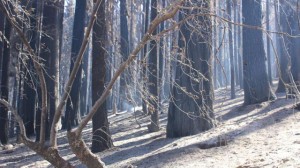Read the edited transcript:
MINA KIM: Lauren, what did it look like?
LAUREN SOMMER: It's pretty dramatic to see in person. It's a very stark landscape. You've got certain areas where what you see is black trees, no branches, no leaves. You've got about a foot of this powdery fine ash on the ground. There are other spots where you still have pine needles left on the trees. A lot of them are dead pine needles, but you see a few glimpses of green here and there. Actually, just this week, the Forest Service released an estimate of the damage. They say about 40 percent was hit with this really high-intensity fire where almost all the vegetation is dead. I think for a lot of people in the Forest Service it's an unprecedented number in California, just because this fire was so large. I spoke to forest ecologist Hugh Safford about this, and this was his reaction.
HUGH SAFFORD: It's not surprising at all. This is just the latest in a string of larger and larger and larger fires we've seen. But the thing that concerns me is the massive size of the huge blocks in the middle of the fire – these giant monolithic areas in which the vegetation has pretty much all been cooked off.
SOMMER: What Safford says is fire is a natural part of this ecosystem, but we're talking about low-intensity fires. With these high-intensity fires, you lose the ecological benefit of fire, and you've got an ecosystem that takes a lot longer to recover.
KIM: Fire officials had been saying the Rim Fire would be 100 percent contained by tomorrow. But you're hearing next month?
SOMMER: Yeah, we're hearing Oct. 1 right now, and that's because these final few areas, kind of on the eastern side of the fire inside Yosemite National Park, where they're going to let it burn out by itself. This is higher elevation. It's rockier. The fire is moving very slow there, and they've decided to just let it peter out. So it's not quite 100 percent contained, but the fire is in good shape.
KIM: With so much area burned and the rainy season coming, I imagine scientists are worried about erosion.
SOMMER: That's a huge concern. There's actually been a team of scientists on the ground for the last two weeks just trying to figure out where is the real erosion danger, and what can they do about it? They're clearing out culverts. They're making sure the drainage is good. What they're really hoping is that we're not going to get a really bad winter with some serious storms up front. They're hoping for some light rain. Maybe the vegetation will have a chance to grow back a little bit, and that will help reduce the danger of erosion.
KIM: What are people saying about how long it will take for this land to come back? And what it will look like when it does?
SOMMER: I think a lot of us wonder that because right now it does look bad. But what the Forest Service says is that ecosystems recover. It's going to come back. Certain types of plants are better at moving into areas than others. And there is a chance that some people say you're going to get shrubs moving in very quickly – maybe too quickly in the sense that trees themselves may not be able to get established. Again, forest ecologist Hugh Safford describes it like this:
SAFFORD: Your typical conifer requires seeds coming in from many miles away, so it's going to take years and years and years for the seeds to even get to the site, probably. You know, that's kind of the big debate always. How long are we willing to wait until we get forest, and how much do we want to allow chance to play a role in that?
SOMMER: Another huge one that we are going to hear a lot about is this problem of fuels. There's too much stuff in our forests and California that is built up because we've been putting out fires so effectively for the past 100 years. I think there's going to be a lot more conversations about that looking ahead.
KIM: This was a really expensive fire, more than $100 million. Is it triggering any new look at fire management policies?
SOMMER: I don't think we can underestimate how important this fire is symbolically. Burning part of Yosemite National Park, being the largest fire in Sierra Nevada ever recorded. A lot of people see this as a moment to revisit some of these forestry policies that have gotten us here.

